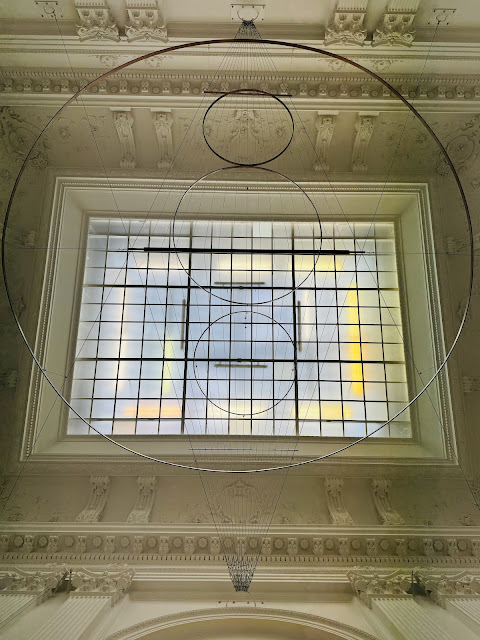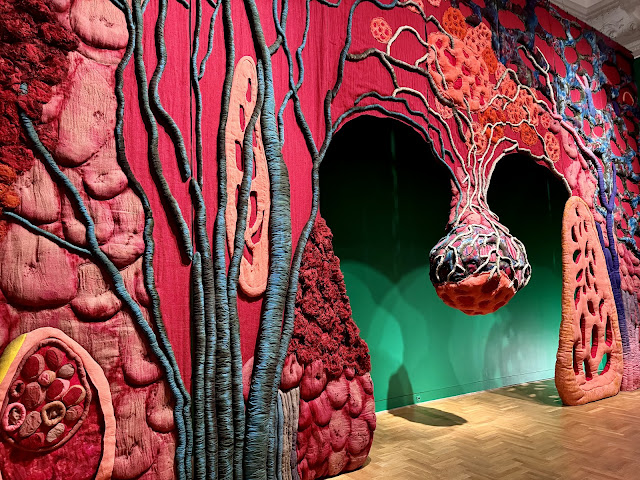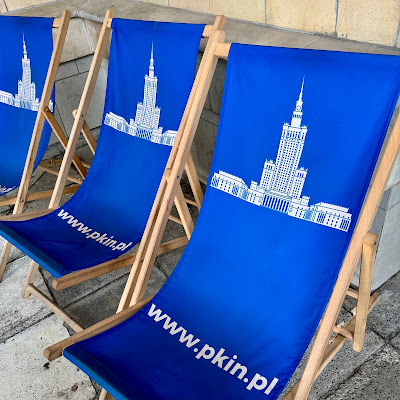Exploring Warsaw, you never really know what's old and what's new given that the Nazis destroyed so much of Poland's capital city after bombing the resistance into submission not long before the war. Had this fellow been flexing his abs for centuries or decades?
But once inside Zacheta, a contemporary art museum, all confusion vanished.
 |
| Sculpture by Prinz Gholam |
Had I known Chopin's heart was interred in Holy Cross Church, I would have paid my respects.
Cardinal Stefan Wyszyński, a former archbishop of Warsaw, is honored outside the Visitationist Church. Although considered a national hero for his strong stands against both the Nazis and the Soviets, and credited with saving several Jews, he laid blame for the 1946 progrom in Kielce on the victims support for communism, not anti-semitism.
Nazis leveled the Royal Castle after the Warsaw uprising in 1944. It now houses an art museum.
Remnants of Sigismund's Column, erected in the mid-17th century to commemorate the king who moved Poland's capital from Kraków to Warsaw, are displayed along side the castle.
A drunken man lolled on the steps of the Church of the Gracious Mother of God, also razed by the Nazis.
Warsaw's sword-wielding mermaid has (mostly) presided over old town square since the mid-19th century.
The four-tower Barbican was reconstructed, brick by brick, after World War II. It had been in place since the mid-16th century although it had no practical utility as a fortification due to changes in artillery power shortly after it was built.
Until I bought David Bowie's Low in 1977, I didn't realize that "Warsawa" was the Polish name of the city. The Thin White Duke intended the haunting instrumental, co-written with Brian Eno, to evoke the urban desolation he had witnessed there the year before, trying desperately to rid himself of his cocaine addiction,
I mixed up the National Museum with the Zacheta National Gallery of Art because of the latter's abbreviated name on the tourist map. No matter. Our visit in the gorgeous building, also rebuilt after the war, offered a respite from what had begun to seem like a week-long lesson in Polish history.
At least for this gladiator, the drawing pencil is mightier than the trident.
 |
| "My Mother Wanted Me to Be Someone" by Olaf Brzeski (2024) |
 |
| "Flowing in Waves Toward Equilibrium" by Iza Tarasewicz (2011-2020) |
A pair of artists, Wolfgang Prinz and Michael Gholam, create under the name Prinz Gholam, including the tiny sculpture at the top of the post and this slightly kinky mural.
 |
| "Parachutes of Elder Flowers" (partial, 2024) |
The sight of stacked animals so startled me that I forgot to identify the artist.
I'll bet you've never seen an epiglottis this large.
 |
| "Untitled (Open Wide)" by Piotr Uklanski (partial, 2012) |
 |
| "Placebo" (1995) |
I'm not crazy about video art but I got a big kick out of two works by Katarzyna Kozyra. Christine, who saw more of the second work, "Summer Tale" told me the little people use an ax to chop off the head of a man dressed as a woman after they spy him standing up to pee.
Cloud cover got in the way of our plan to watch the sun set over the city from the viewing platform at the top of the Soviet-era Palace of Culture & Science, once one of the ten tallest buildings in the world. Imagine how it must have dominated the skyline when Bowie visited in 1976.
First we had to get past this huge guy.
This ceiling belies the drab interior of the elevator lobby.
Polish businesses like to brand their outdoor seating.
Warsaw rising, indeed.
I preferred the view down below.
More Poland
Gdansk:
Kraków:





















No comments:
Post a Comment